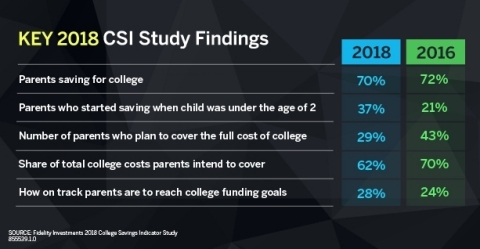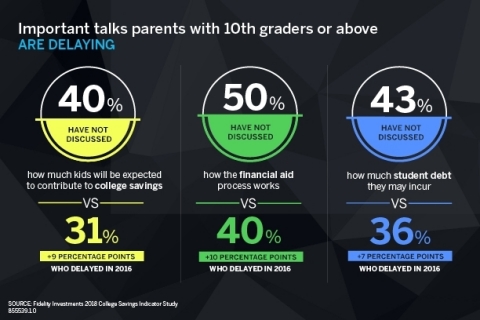BOSTON--(BUSINESS WIRE)--How are American families coping with the sticker shock of college? Although they will most likely be paying for new school supplies when school starts this year, many parents—particularly those carrying their own student debt—are asking kids to share more of the responsibility for funding college. Findings from Fidelity Investments’® 2018 College Savings Indicator Study also reveal that although many parents are saving earlier, it’s still not enough: More parents are starting to save before their child reaches the age of two—37 percent, up from 21 percent in 2016—but are on track to meet just 28 percent of their college funding goals. The good news: this important college savings indicator is up from 24 percent in 2016.
Part of this improvement comes because parents expect their children to take on a greater share of college costs. While still planning to cover the majority of the costs (62 percent) themselves, the study found parents want their children to set aside a whopping average of $15,385 by high school graduation, up from $12,431 in 2016. Similarly, fewer parents feel it’s their obligation to foot the whole bill for their children’s college (49 percent, down from 56 percent in 2016). (See graphic on “Key 2018 CSI Study Findings.”)
Considering these enhanced expectations, it’s surprising that many parents are delaying critical conversations with their children about chipping in for college. In fact, 40 percent of parents with sophomores or older haven’t discussed with their kids that they’re expected to contribute to college savings, up from 31 percent in 2016.
“The study’s findings are a sobering wake-up call for parents to improve communications with college-bound kids,” said Melissa Ridolfi, vice president of Retirement and College Products at Fidelity. “It’s no wonder parents today are more realistic about how much they can contribute to their kids’ education, as nearly one in five are still struggling to pay off their own student debt while saving for retirement. Expecting children to assume more responsibility for college costs makes sense—but the right time for the college talk is long before the first tuition bill is due.”
How much kids will be expected to pitch in isn’t the only topic many parents of 10th graders or older are putting off. (For a look at other delayed conversations, see graphic on “Important talks parents with 10th graders or above are delaying.”)
Parents Need More Help on the Savings Front
Although the
survey reveals that 86 percent of parents feel they are better educated
about their finances having dealt with their own student loan debt, more
can be done to maximize college savings for their kids. Fifty percent of
parents admit they don’t know the best accounts for college savings and
express uncertainty regarding exactly how much to save each month. One
possible factor: only 56 percent indicate they have a financial plan in
place to reach college savings goals, the lowest level since the
question was first asked in 2013. It’s also a sharp decline from 2016,
when two in three parents had a plan in place.
As families look to get on track, advisors can play an instrumental role in helping parents set up a clear college savings plan, and four in ten respondents indicate they have a one-on-one relationship with a financial professional to help make financial decisions (consistent with 2016 at 41 percent). A clear majority (64 percent) of families feel they are closer to achieving their college saving goals thanks to the help of their advisors. Further, when one compares families who have an advisor against those who do not, those with an advisor demonstrate greater confidence in their savings plans. (See graphic on “Achieving your college saving goals.”)
While having an advisor can potentially help families increase the amount they put away each month for higher education, this year’s study uncovers several opportunities for advisors to add greater value by discussing education goals and available savings strategies with family members:
- More than one out of three (34 percent) of families with advisors haven’t discussed 529 plans.
- Only 29 percent said their financial advisor had discussed the accelerated gifting option with them, down from 45 percent in 2016.
- 36 percent said their advisor did not meet with their child and 23 percent said their advisor did not provide them with information or materials to discuss with their child.
“Clearly there is an opportunity for advisors to initiate a conversation about college savings with both parents and their children,” said Ron Hazel, senior director of Fidelity Advisor 529 and individual retirement products. “Advisors can help parents create savings plans and evaluate investment strategies, but it’s equally important to discuss those goals directly with their children. These discussions can serve as a foundation for younger family members’ financial literacy as advisors begin to build long-term relationships with the next generation of investors.”
Most Families Need Education about Recent 529 Tax Law Changes
Another
area where families need additional information is tied to recent tax
law changes enacted by Congress related to 529s, which allow holders to
use a portion of their 529 funds for K-12 tuition. Almost seven in 10
(69 percent) of parents are unaware of this change. Additionally, it’s
uncertain how big an impact the change will have, with 30 percent
indicating it would not encourage them to open a 529 and almost one half
(49 percent) saying they weren’t sure. Four in 10 of those with a 529
(or those who plan to open one) say it would not be used for K-12
tuition, while an additional one in four don’t know. (Read this
Viewpoints article for information on whether the recent 529 tax
change makes sense for you.)
Tips and Resources to Help Parents Save More for College
For
parents looking for additional ways to defray college costs, respondents
share this advice: save as early as possible for college (46 percent);
open a dedicated savings account as soon as your child is born (28
percent); and treat saving for college like paying a bill for yourself
(26 percent).
Looking for more ways to boost your college savings? Fidelity has additional resources available to help families:
- Viewpoints articles providing more insights on college topics, including: 5 lessons learned for college savings; Tips for raising a saver; How much college can you really afford? and a Student loan guide. Additionally, developed for a younger generation of parents who are constantly on-the-go, Fidelity.com/mymoney offers short, interactive financial resources.
- Fidelity’s online College Savings Quick Check calculator can show parents the impact of saving a few extra dollars each month, based on their own timeline.
- Fidelity’s College Savings Learning Center provides a library of online resources for parents, including video courses on saving account options and strategies and resources on more ways to pay for college—such as how to apply for financial aid and scholarships.
- Asking friends and family to consider gifting to college savings for birthdays or other holidays is becoming more common. To make contributing easier, Fidelity offers a 529 Online Gifting Service, which lets owners of Fidelity’s retail 529 college savings accounts encourage friends and family to help them save for college.
- In-person guidance from college planning representatives, available at Fidelity’s 197 nationwide investor centers or by calling 800-544-1914. Fidelity also provides financial advisor clients with 529 plan information, marketing support and online tools such as the 529 State Tax Deduction Calculator and the College Savings Planning tool. Financial advisors can get more information at institutional.fidelity.com/529 or 1-800-544-9999
About the Fidelity Investments 2018 College Savings Indicator Study
As
part of the study, Fidelity conducted a survey of parents with
college-bound children of all ages. Parents provided data on their
current and projected household asset levels including college savings,
use of an investment advisor and general expectations and attitudes
toward financing their children’s college education. Using Fidelity’s
proprietary asset-liability modeling engine, the company was able to
calculate future college savings levels per household against
anticipated college costs. The results provided insight into the
financial challenges parents face in saving for college. Data for the
Indicator (number of children in household, time to matriculation,
school type, current savings and expected future contributions) was
collected by Boston Research Technologies, an independent research firm,
through an online survey from May 15 – June 15, 2018 of 1,899 families
nationwide with children aged 18 and younger who are expected to attend
college. The survey respondents had household incomes of at least
$30,000 a year or more and were the financial decision makers in their
household. College costs were sourced from the College Board’s Trends in
College Pricing 2017. Future assets per household were computed by
Fidelity Personal and Workplace Advisors LLC (FPWA), a registered
investment adviser and a Fidelity Investments company. Within Fidelity’s
asset-liability model, Monte Carlo simulations were used to estimate
future assets at a 75 percent confidence level. The results of the
College Savings Indicator may not be representative of all parents and
students meeting the same criteria as those surveyed for the study. For
more information, an Executive
Summary can be found on Fidelity.com.
About Fidelity Investment
Fidelity’s mission is to inspire
better futures and deliver better outcomes for the customers and
businesses we serve. With assets under administration of $7.2 trillion,
including managed assets of $2.6 trillion as of July 31, 2018, we focus
on meeting the unique needs of a diverse set of customers: helping more
than 27 million people invest their own life savings, 23,000 businesses
manage employee benefit programs, as well as providing more than 12,500
financial advisory firms with investment and technology solutions to
invest their own clients’ money. Privately held for 70 years, Fidelity
employs more than 40,000 associates who are focused on the long-term
success of our customers. For more information about Fidelity
Investments, visit https://www.fidelity.com/about.
Please carefully consider the plan's investment objectives, risks, charges, and expenses before investing. For this and other information on any 529 college savings plan managed by Fidelity, contact Fidelity for a free Fact Kit, or view one online. Read it carefully before you invest or send money.
The UNIQUE College Investing Plan, the Fidelity Advisor 529 Plan, the U.Fund® College Investing Plan, the Delaware College Investment Plan and the Fidelity Arizona College Savings Plan are offered by the state of New Hampshire, MEFA, the state of Delaware, and the Arizona Commission for Postsecondary Education, respectively, and managed by Fidelity Investments. If you or the designated beneficiary are not a New Hampshire, Massachusetts, Delaware or Arizona resident, you may want to consider, before investing, whether your state or the designated beneficiary’s home state offers its residents a plan with alternate state tax advantages or other benefits.
Units of the portfolios are municipal securities and may be subject to market volatility and fluctuation.
Fidelity, Fidelity Investments, Fidelity Advisor Funds, and the Fidelity Investments & Pyramid Design logo are registered service marks of FMR LLC.
The third party marks appearing herein are the property of their respective owners.
Boston Research Technologies is not affiliated with Fidelity Investments.
855539.1.0
© 2018 FMR LLC.






